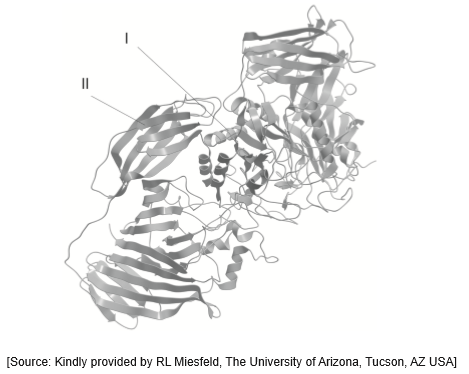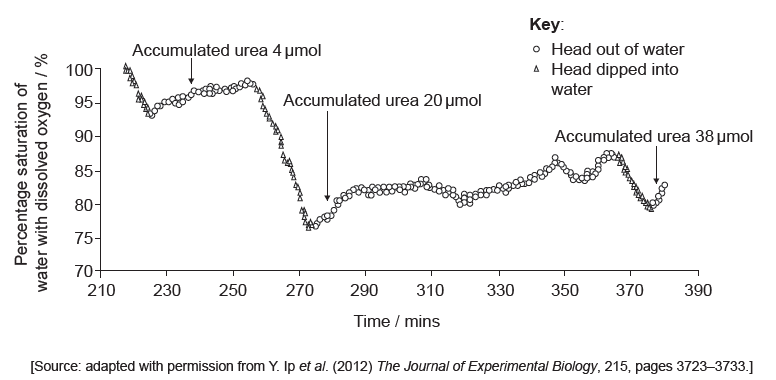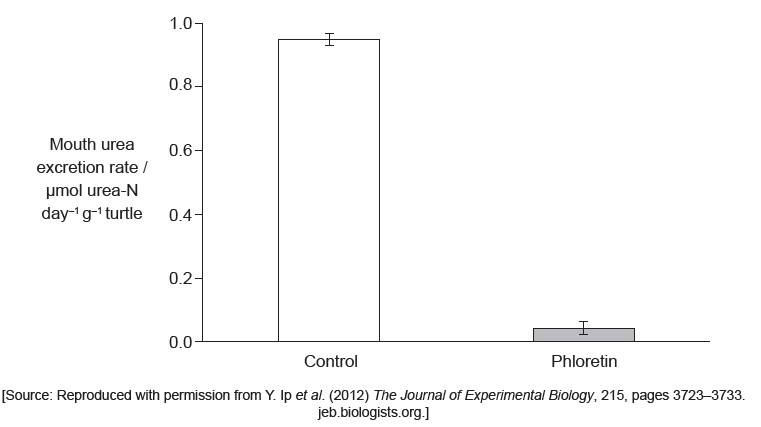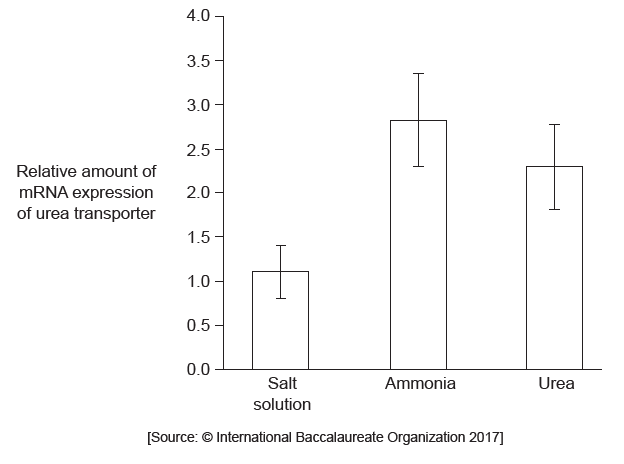Question
a. Outline the action of enzymes.[4]
b. Explain the roles of specific enzymes in prokaryote DNA replication.[7]
c.Many genetic diseases are due to recessive alleles of autosomal genes that code for an enzyme. Using a Punnett grid, explain how parents who do not show signs of such a disease can produce a child with the disease.[4]
▶️Answer/Explanation
Ans:
Catalyse/speed up reactions
Substrate-specific
Lower the activation energy «of a chemical reaction»
Substrate collides with/binds to active site
Enzyme–substrate complex formed
OR
transition state formed
OR
bonds in substrate weakened
«DNA» gyrase/topoisomerase «II» prepares for uncoiling/relieves strains «in the double helix»
Helicase uncoils/unwinds the DNA/double helix
Helicase separates/unzips/breaks hydrogen bonds between the two strands of DNA
«DNA» primase adds an RNA primer/short length of RNA Accept RNA primase.
DNA polymerase III adds «DNA» nucleotides/replicates DNA/synthesizes complementary strand in a 5’ to 3’ direction
DNA polymerase III starts replication/adding nucleotides at the primer
DNA polymerase I removes the primer
OR
replaces RNA with DNA
«DNA» ligase seals the nicks
OR
links sections of replicated DNA
OR
links Okazaki fragments
DNA polymerase I/DNA polymerase III proofreads for mistakes
Key or text giving alleles with upper case for dominant allele and lower case for recessive allele/allele causing disease
Reject key showing a sex linked gene such as hemophilia.
Reject if X or Y chromosomes are shown with the alleles.
Accept Aa or any other upper and lower case letters.
Punnett grid showing that both parents can pass on either a dominant or a recessive allele in their gamete
For example row and column headings with A and a.
This mark can be awarded if X or Y chromosomes are shown but each parent has one recessive and one dominant allele as if for autosomal inheritance.
Four possible genotypes for child correctly shown on grid
AA, Aa, aA and aa for example.
This mark can be awarded if X or Y chromosomes are shown but the genotypes are correct for autosomal inheritance.
Double/homozygous recessive shown having the disease
Cannot be awarded with sex linkage.
25 % or 0.25 or 1/4 chance of inheriting the disease
This mark can be awarded if X or Y chromosomes are shown but the ratio is
correct for autosomal inheritance
Question
The diagram below shows the structure of lactase

a. A study of 600 adolescents in Sweden showed that milk consumption has a positive effect on height which shows continuous variation. However, milk contains lactose which some people can digest but some cannot.
State the pattern of inheritance that contributes to continuous variation.
State the pattern of inheritance that contributes to continuous variation.
a ii(Explain the production of lactose-free milk.
b i(Identify the protein structures indicated by I and II.
$\mathrm{I}$ :
II:
$\mathrm{b}$ (i)Describe how structure I is held together.
$\mathrm{b}$ (iii)his protein is described as a globular protein. Distinguish between globular and fibrous proteins.
Question
The Chinese soft-shelled turtle, Pelodiscus sinensis, lives in salt water marshes. The turtle can live under water and out of water.
These turtles have fully developed lungs and kidneys, however, many microvilli have been discovered in the mouth of P. sinensis. A study was undertaken to test the hypothesis that oxygen uptake and urea excretion can simultaneously occur in the mouth.
Initial experiments involved collecting nitrogen excretion data from P. sinensis. The turtle urinates both in water and out of water. When in water it allows waste products to be washed out of its mouth. When out of water it regularly dips its head into shallow water to wash its mouth. The table shows the mean rates of ammonia and urea excretion from the mouth and kidney over six days.

It was noted that during long periods out of water, turtles rhythmically moved their mouths to take in water from a shallow source and then discharge it. Changes in the dissolved oxygen and the quantity of accumulated urea in the rinse water discharged by the turtles were monitored over time as shown in this graph.

In order to test whether a urea transporter was present in the mouth tissues of the turtles, phloretin (a known inhibitor of membrane proteins that transport urea) was added to the water in which a further set of turtles submerged their heads. The results of that treatment are shown.

Further research was conducted to determine where mRNA expression of a urea transporter gene might be occurring in P. sinensis. Gel electrophoresis was used to analyse different tissue samples for mRNA activity.

Expression of the urea transporter gene by cells in the turtle’s mouth was assessed by measuring mRNA activity. Turtles were kept out of water for 24 hours and then injected with either a salt solution that matched the salt concentration of the turtle, dissolved ammonia or urea, followed by another 24 hours out of water.

Deduce whether the excretion of ammonia or urea changes more when a turtle emerges from water.[2]
Compare and contrast the changes in urea excretion in the mouth with the changes in urea excretion in the kidney when a turtle emerges from the water.[3]
Describe the trends shown by the graph for dissolved oxygen in water discharged from the mouth.[1]
Suggest reasons for these trends in dissolved oxygen.[2]
Deduce with a reason whether a urea transporter is present in the mouth of P. sinensis.[2]
Outline the additional evidence provided by the gel electrophoresis results shown above.[2]
Identify which of these turtle groups represent the control, giving a reason for your answer.[1]
Suggest a reason for the greater expression of the gene for the urea transporter after an injection with dissolved ammonia than an injection of urea.[2]
The salt marshes where these turtles live periodically dry up to small pools. Discuss the problems that this will cause for nitrogen excretion in the turtles and how their behaviour might overcome the problems.[3]
▶️Answer/Explanation
Markscheme
a. urea
b. for both mouth and kidney
c. percentage change/change in μmol day−1 g−1 greater with urea/other acceptable numerical comparison
a. both higher/increased on emergence from/with turtle out of water
b. both increased by 0.66 «μmol−1 g−1 when turtle emerges from water»
c. % increase is higher in kidney / kidney 940% versus mouth 73/75% / increase is higher proportionately higher in kidney / kidney x10 versus mouth nearly double/x1.73
d. urea excretion by mouth greater than kidney out of water «despite larger % increase in kidney excretion»
decrease «when head is submerged» and increase when head is out of water
a. oxygen absorbed from water/exchanged for urea when head dipped in water«so oxygen concentration decreases»
b. lungs cannot be used with head in water / can «only» be used with head out of water
c. oxygen from water «in mouth» used in «aerobic cell» respiration
d. oxygen from air dissolves in water when head out of water «so oxygen concentration increases»
a. urea transporter is present
b. less urea «excreted»/ lower rate «of urea excretion» / excretion almost zero when phloretin/inhibitor was present
a. mRNA only in mouth and tongue/in mouth and tongue but not esophagus intestine kidney or bladder
b. bands / lines indicate mRNA for/expression of urea transporter gene
c. urea transporter gene expressed / urea transporters in mouth/tongue / not expressed/made in esophagus/intestine/kidneys/bladder
d. mRNA/transcription/gene expression/urea transporters higher in tongue/more in tongue «than mouth»
salt solution is control because it does not contain a nitrogenous/excretory waste product / it matches the salt concentration of the turtle / the turtle’s body already contains salt / because the turtle lives in salt water/salt marshes / because nothing has been altered
a. ammonia is «highly» toxic/harmful
b. ammonia is more toxic than urea/converse
c. ammonia converted to urea
d. urea concentration raised «by injecting ammonia»
e. difference between ammonia and urea «possibly» not «statistically» significant
Problems:
a. urea becomes more concentrated «in small pools» / lower concentration gradient «between tongue/mouth and water»
b. less water available for urine production/excretion by kidney
OR
less water in ponds for mouth rinsing/more competition for pools (to use for mouth rinsing)
Behaviour to overcome problems:
c. «still able to» dip mouth into/mouth rinse in water/pools
d. «still able to» excrete urea «though the mouth» in the small pools
e. more conversion of ammonia to urea/urea excretion rather than ammonia
f. more urea transporters/expression of urea transporter gene
g. urea excreted «in mouth/via microvilli» by active transport/using ATP
h. excretion with little/no loss of water
Question
a. Outline the action of enzymes.
b. Explain the roles of specific enzymes in prokaryote DNA replication.
c.Many genetic diseases are due to recessive alleles of autosomal genes that code for an enzyme. Using a Punnett grid, explain how parents who do not show signs of such a disease can produce a child with the disease.
▶️Answer/Explanation
Markscheme
a.)Catalyse/speed up reactions
Substrate-specific
Lower the activation energy «of a chemical reaction»
Substrate collides with/binds to active site
Enzyme–substrate complex formed
OR
transition state formed
OR
bonds in substrate weakened
«DNA» gyrase/topoisomerase «II» prepares for uncoiling/relieves strains «in the double helix»
Helicase uncoils/unwinds the DNA/double helix
Helicase separates/unzips/breaks hydrogen bonds between the two strands of DNA
«DNA» primase adds an RNA primer/short length of RNA Accept RNA primase.
DNA polymerase III adds «DNA» nucleotides/replicates DNA/synthesizes complementary strand in a 5’ to 3’ direction
DNA polymerase III starts replication/adding nucleotides at the primer
DNA polymerase I removes the primer
OR
replaces RNA with DNA
«DNA» ligase seals the nicks
OR
links sections of replicated DNA
OR
links Okazaki fragments
DNA polymerase I/DNA polymerase III proofreads for mistakes
c.)Key or text giving alleles with upper case for dominant allele and lower case for recessive allele/allele causing disease
Reject key showing a sex linked gene such as hemophilia.
Reject if X or Y chromosomes are shown with the alleles.
Accept Aa or any other upper and lower case letters.
Punnett grid showing that both parents can pass on either a dominant or a recessive allele in their gamete
For example row and column headings with A and a.
This mark can be awarded if X or Y chromosomes are shown but each parent has one recessive and one dominant allele as if for autosomal inheritance.
Four possible genotypes for child correctly shown on grid
AA, Aa, aA and aa for example.
This mark can be awarded if X or Y chromosomes are shown but the genotypes are correct for autosomal inheritance.
Double/homozygous recessive shown having the disease
Cannot be awarded with sex linkage.
25 % or 0.25 or 1/4 chance of inheriting the disease
This mark can be awarded if X or Y chromosomes are shown but the ratio is
correct for autosomal inheritance.
Question
a(i) A study of 600 adolescents in Sweden showed that milk consumption has a positive effect on height which shows continuous variation. However, milk contains lactose which some people can digest but some cannot.
State the pattern of inheritance that contributes to continuous variation. [1]
Explain the production of lactose-free milk.
a (i)Explain the production of lactose-free milk.
b (iI)Identify the protein structures indicated by I and II.
I:
II:
b (i)Describe how structure I is held together.
b (ii)this protein is described as a globular protein. Distinguish between globular and fibrous proteins.
▶️Answer/Explanation
Markscheme
a (i)polygenic / more than one gene
Accept polygenetic. Mark only first answer if more than one answer given.
a (il)actase added to milk / lactase immobilised;
lactose hydrolysed/broken down into glucose and galactose;
for people who are lactose intolerant/lack lactase;
increases sweetness/solubility/smooth texture (in processed foods);
$\mathrm{b}$ (i). is alpha helix and II is beta pleated sheet
Reject ( $\alpha$ ) double helix but accept $\alpha / A / a$ and $\beta / B / b$ instead of alpha and beta.
b (iii)hydrogen bonds;
Reject hydrogen and covalent bonds unqualified and hydrogen bonds between bases.
(hydrogen bonds) between $\mathrm{N}-\mathrm{H}$ and $\mathrm{C}=\mathrm{O}$ (on different amino acids);
Reject between amine and carboxyl groups.
(hydrogen bonds) between adjacent turns of the helix/every fourth amino
acid;
Accept above points in an annotated diagram.

A table is not required but for each feature the difference between globular and fibrous
proteins must be made clear.
Question
a.Define the active site of an enzyme.[1]
b.Explain how the active site promotes enzyme–substrate specificity. [2]
c.Outline possible effects of acids on enzyme activity. [2]
▶️Answer/Explanation
Markscheme
a. region/site where a substrate binds
b. a. shape of active site matches that of the substrate;
b. chemical properties/charges of active site attract the substrate;
c. active site can change to induce fit of substrate;
a. changes the charge/ionization of amino acids/R-groups;
b. changes 3-D structure (of active site)/tertiary structure / denatures enzyme;
c. substrate no longer binds/fits so decreases activity;
d. could increase activity if optimum $\mathrm{pH}$ of enzyme is acidic;
Question
a.)Outline the effect of temperature and substrate concentration on the activity of enzymes.[4]
b.)Distinguish between competitive and non-competitive enzyme inhibition of chemical reactions, giving an example of each.[5]
c.)Explain the light-independent reactions of photosynthesis.
▶️Answer/Explanation
Markscheme
a.)enzymes most active at one temperature/optimum temperature;
any deviation from that temperature lowers the enzyme activity;
denaturing/change in active site/no activity at higher temperatures / inactivated at (very) low temperatures;
increasing the substrate concentration increases the enzyme activity/more enzyme-substrate complex formed/more collisions between enzyme and substrate;
eventually no increase in enzyme activity with increased substrate concentration / plateau when enzymes are working to the maximum/when all active sites occupied/saturated;
Accept answers shown graphically.
b.)example of competitive; (e.g. malonate competes with succinate dehydrogenase)
example of non-competitive; (e.g. opioids inhibit nitric oxide synthase)

Award [2 max] for examples and [1] for each correct paired statements up to [3 max].
Answers do not need to be shown in a table format.
take place in the stroma of the chloroplast;
produce carbohydrates;
ribulose bisphosphate/RuBP is a five carbon compound;
carbon dioxide fixed/added to RuBP / carboxylation;
by RuBP carboxylase (enzyme)/Rubisco;
forms unstable six carbon compound;
this splits into (two molecules of) glycerate-3-phosphate/GP;
ATP and NADPH produced in light-dependent reaction;
ATP provides the energy;
GP reduced to triose phosphate/TP;
NADPH provides hydrogen;
some three carbon sugars go to form hexose sugars;
some go to making more RuBP;
called the Calvin (Benson) cycle;
Question
a.Distinguish between RNA and DNA.[3]
b.Explain the process of DNA replication. [8]
c.Outline how enzymes catalyse reactions.[7]
▶️Answer/Explanation
Markscheme
a.)DNA is double-stranded while RNA is single-stranded;
DNA contains deoxyribose while RNA contains ribose;
the base thymine found in DNA is replaced by uracil in RNA;
one form of DNA (double helix) but several forms of RNA (tRNA, mRNA and rRNA);
occurs during (S phase of) interphase/in preparation for mitosis/cell division;
DNA replication is semi-conservative;
unwinding of double helix / separation of strands by helicase (at replication origin);
hydrogen bonds between two strands are broken;
each strand of parent DNA used as template for synthesis;
synthesis continuous on leading strand but not continuous on lagging strand;
leading to formation of Okazaki fragments (on lagging strand);
synthesis occurs in 5’→3′ direction;
RNA primer synthesized on parent DNA using RNA primase;
DNA polymerase III adds the nucleotides (to the 3′ end)
added according to complementary base pairing;
adenine pairs with thymine and cytosine pairs with guanine; (Both pairings required. Do not accept letters alone.)
DNA polymerase I removes the RNA primers and replaces them with DNA;
DNA ligase joins Okazaki fragments;
as deoxynucleoside triphosphate joins with growing DNA chain, two phosphates broken off releasing energy to form bond;
Accept any of the points above shown on an annotated diagram.
they increase rate of (chemical) reaction;
remains unused/unchanged at the end of the reaction;
lower activation energy;
activation energy is energy needed to overcome energy barrier that prevents reaction;
annotated graph showing reaction with and without enzyme;
substrate joins with enzyme at active site;
to form enzyme-substrate complex;
active site/enzyme (usually) specific for a particular substrate;
enzyme binding with substrate brings reactants closer together to facilitate chemical reactions (such as electron transfer);
induced fit model / change in enzyme conformation (when enzyme-substrate/ES complex forms);
making the substrate more reactive;
Question
The equation below shows the production of glucose and galactose from lactose.

Glucose and galactose are examples of monosaccharides. State one other example of a monosaccharide.
There are several different types of carbohydrate. State which type of carbohydrate lactose is.
State the type of chemical reaction that occurs when lactose is digested into glucose and galactose.
Simple laboratory experiments show that when the enzyme lactase is mixed with lactose, the initial rate of reaction is highest at 48°C. In food processing, lactase is used at a much lower temperature, often at 5°C. Suggest reasons for using lactase at relatively low temperatures.
fructose/ribose/deoxyribose/ribulose/other monosaccharides apart from glucose and galactose
▶️Answer/Explanation
Ans:
a. fructose/ribose/deoxyribose/ribulose/other monosaccharides apart from glucose and galactose
b (ii)dlisaccharide
$\mathrm{b}$ (ii)hydrolysis
less denaturation / enzymes last longer at lower temperatures;
lower energy costs / less energy to achieve $5^{\circ} \mathrm{C}$ compared to $48^{\circ} \mathrm{C}$;
reduces bacterial growth / reduces (milk) spoilage;
to form products more slowly / to control rate of reaction;
Question
a.Draw a labelled diagram of the digestive system. [4]
b.Many people cannot digest lactose and benefit from a diet containing no lactose. Outline the production of lactose-free milk. [6]
c.Explain how the kidney helps to retain useful substances in the blood and eliminate substances which the body does not need.[8]
▶️Answer/Explanation
Markscheme
a.)Award [1] each for the following structures clearly drawn and correctly labelled.
esophagus – connected to top of stomach;
stomach – connected to small intestine;
small and large intestines – connected to each other;
liver shown as larger than the stomach with gall bladder shown under/embedded in liver;
gall bladder – connected to the small intestine (via bile duct);
pancreas – connected to small intestine (via pancreatic duct);
b.)milk contains lactose / lactose is milk sugar;
lactose is broken down to glucose and galactose;
by (the enzyme) lactase;
which is lacking in people with lactose intolerance;
lactose-free milk is sweeter than milk containing lactose;
lactase produced by small intestine / produced by yeast sometimes found in milk;
can be added directly to milk;
immobilized in beads / biotechnological techniques;
ultrafiltration of milk to remove lactose;
ultrafiltration occurs in the glomerulus;
basement membrane acts as a filter;
preventing proteins/cells from passing;
(filtered) substances pass to the Bowman’s capsule;
to proximal convoluted tubule (PCT);
(where there is) selective reabsorption;
(in PCT) all glucose/amino acids are reabsorbed;
(in PCT most) water reabsorbed;
surrounding the loop of Henle, is an area of high solute concentration;
in distal convoluted tubule, ions are exchanged between filtrate and blood;
collecting duct has role in osmoregulation;
ADH regulates the amount of water reabsorbed;
substances not reabsorbed are eliminated as urine;